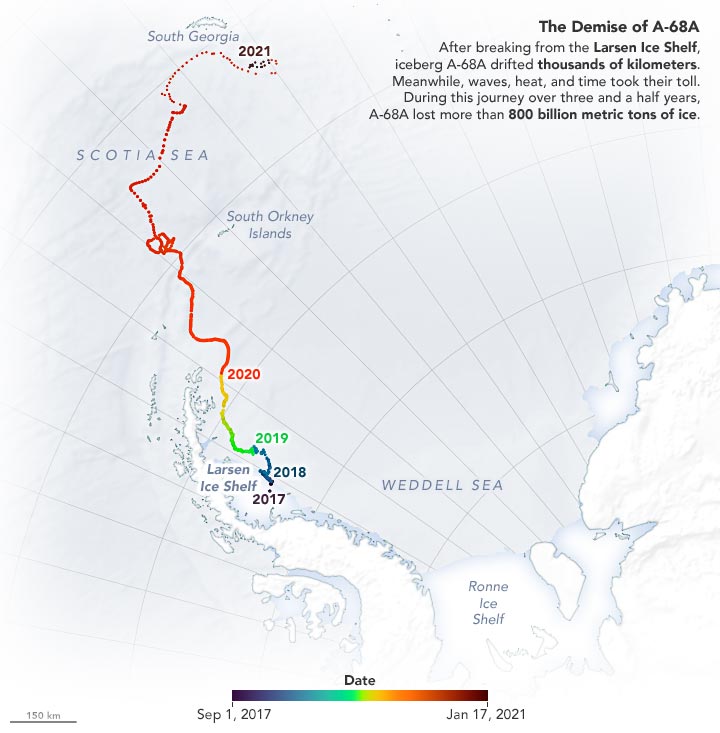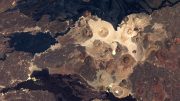Researchers recently chronicled the death throes of A-68A, one of the world’s largest-known icebergs.
As soon as an iceberg is born it starts to die. Waves chip away at its edges, air thaws it from above, and water melts it from below. Scientists recently documented such death throes for one of the world’s largest-known icebergs.
In July 2017, Iceberg A-68 broke from the Larsen C Ice Shelf, along the east coast of the Antarctic Peninsula. At the time, it was the largest iceberg in the world and the sixth-largest berg in three decades of records. It measured nearly 5,800 square kilometers (2,200 square miles), or about the size of the state of Delaware. In other words, A-68 had a lot to lose. Across three and a half years, the berg broke apart and melted, leaving its mark on the ocean environment, especially near the remote island of South Georgia.
“Icebergs are a source of cold fresh water and nutrients in the Southern Ocean,” said Anne Braakmann-Folgmann, a doctoral candidate at the University of Leeds. “However, where and how much of this is released is not very well studied and not included in ocean models yet, especially for the largest icebergs.”
Braakmann-Folgmann and colleagues set out to chart the journey of A-68A. (The new name was given to the main berg after a few small pieces broke off.) The researchers used satellite data to document changes in the iceberg’s thickness, area, volume, and mass from the time it broke from the ice shelf in July 2017 until it started to quickly disintegrate in January 2021.
The maps above show where and when the iceberg thinned as it drifted north from the Weddell Sea into the Scotia Sea. The first map (left) shows the berg’s thickness in July 2017, when it was still near the Larsen C Ice Shelf. Notice that it is thicker on its left side, where it was attached to the ice shelf, and thinner on the right side, where it was exposed to the ocean. Its total average thickness was 235 meters (771 feet) at the time. As the berg drifted north, it met warmer air and water temperatures, which accelerated melting. By January 2021, when the berg closed in on South Georgia, it had thinned to an average thickness of 168 meters (551 feet).
About 85 percent of an iceberg lies below the water’s surface—less than ideal for measuring its total thickness. But scientists can now estimate the thickness by measuring components of the iceberg that are above the water. Data from NASA’s Ice, Cloud, and land Elevation Satellite 2 (ICESat-2) and the European Space Agency’s CryoSat-2 (laser and radar altimeters, respectively) can indicate the distance from the satellite to the surface of the iceberg and to the surface of the sea. The difference between these measurements is known as the iceberg’s “freeboard”—the height of the ice that rises above the water. Scientists can then convert this height into thickness by accounting for the densities of the iceberg, the snow layer on top, and the surrounding sea water.
The researchers showed that from July 2017 until January 2021, melting from the bottom of the iceberg accounted for 32 percent of its loss. Melting peaked near South Georgia, where the scientists estimated that 152 billion metric tons (152 billion cubic meters) of fresh water was added to the ocean—the equivalent of 61 million Olympic swimming pools—over the span of three months. Scientists are still investigating the effect of all this fresh water on local ocean properties. They also want to know if the extra nutrients supplied to the ocean by the melting iceberg fostered any biological production.
Other ice losses occurred when large pieces broke away from the sides of the berg. This was especially the case when A-68A left the protective sea ice near Antarctica and moved to the north, where it was exposed to the destructive waves of the open ocean. Thinning and fragmentation both increased as the iceberg drifted north, but fragmentation finally dominated as the iceberg disintegrated in the Northern Scotia Sea.
NASA Earth Observatory images by Joshua Stevens, using data courtesy of Braakmann-Folgmann, A. et al. (2022) and The Antarctic Iceberg Tracking Database at Brigham Young University.











Be the first to comment on "Tracking the Demise of One of the World’s Largest-Known Icebergs"